Egypt Travel Information and Travel Guide
Our company is a full service Travel Agent
in Egypt that helps individuals, small and large groups of tourists to
enjoy the beauty of the unforgettable Egypt by spend a nice Tour Egypt. We
can plan for you a perfect Vacation in Egypt, weekend, or Honeymoon Trip
to Egypt.
There are many tours to be done in Egypt, different types of tours and
packages are available. A tour to Egypt is a great idea during winter, as
weather is quite warm compared to other countries. All tours are escorted
by a pro. guide (language depends on the group), also you can have free
tours depending on your package. Yes, It is safe to travel to Egypt, don't
worry !
The land that gave birth to the first great
civilization needs little introduction. The pyramids, the minarets, the
Nile – the scope of Egypt is magnificent.
Visitors are surprised to discover that those legendary pyramids are
merely the tip of the archaeological iceberg. Pharaonic nations, ancient
Greeks, Romans, Christians and Arab dynasties have all played their part
in fashioning Egypt’s embarrassment of architectural wealth.
Cairo’s chaos whirrs around a medieval core that has remained unchanged
since the founding days of Islam. Upriver, Luxor, the site of ancient
Thebes, is lined with warrens of opulent burial chambers and boasts some
of the most formidable monuments in all antiquity. Further south at Aswan,
even more geometrically imposing temples write a testament to the power of
archaic gods and omnipotent pharaohs. It is here that the Nile is best
explored by ancient sail, on a felucca (Egyptian sailing boat) at the
hands of the prevailing currents and winds.
Out west, Egypt’s ocean of sand stretches infinitely to the Sahara, with a
handful of oases feeding solitary islands of green. Hivelike, medieval
fortresses cower out here, interspersed with bubbling springs and ghostly
rock formations. Meanwhile, the deep, crystal waters of the Red Sea lie
brilliantly awash in coral, surrounded by an aquatic frenzy of underwater
life. In the deserts of Sinai’s interior, visitors can climb the mount
where God had word with Moses, and spend their remaining days in halcyon
bliss at coastal Dahab’s backpacker Shangri-La.
Though it is one of the more politically stable countries in the region,
modern-day Egypt is not without strife. Thirty years of authoritarian
rule, an erratic economy and rising living costs fan the flames of social
unrest. Still, Egyptians are a resilient lot, and visitors making the
journey here will find as much ancient history as they will modern
hospitality.
Weather
Egypt’s climate is easy to summarise: hot and dry, with the exception of
the winter months of December, January and February, which can be quite
cold in the north. Average temperatures range from 20°C (68°F) on the
Mediterranean coast to 26°C (80°F) in Aswan. Maximum temperatures for the
same places can get up to 31°C (88°F) and 50°C (122°F), respectively. At
night in winter the temperature sometimes plummets to as low as 8°C in
Cairo and along the Mediterranean coast. In the desert it’s even more
extreme – often scorching during the day and bitterly cold at night.
Alexandria receives the most rain, approximately 19cm a year, while far to
the south in Aswan the average is about 10mm over five years. Al-Kharga in
the Western Desert once went 17 years without any rain at all.
Between March and April the khamsin (a dry, hot wind) blows in from the
parched Western Desert at up to 150km/h. The sky becomes dark orange and
choked with dust and, even when everyone closes all doors and windows
tightly, the inside of every house is covered with a patina of grit so
that they resemble undisturbed tombs.
When to go
The best time to visit Egypt depends on where you want to go. Generally
speaking, winter (December to February) is the tourist high season and
summer (June to August) is the low season in all parts of the country
except on the coasts, and to a lesser degree in Cairo. Hotel prices
reflect this.
Weather-wise, June to August is unbearable almost anywhere south of Cairo,
especially around Luxor and Aswan, where daytime temperatures soar up to
40°C. Summer in Cairo is almost as hot, and the combination of heat, dust,
pollution, noise and crush makes walking the city streets a real test of
endurance. On the other hand, a scorching sun might be exactly what’s
wanted for a week or two of slow roasting on the beaches of southern
Sinai, the Alexandrian coast or the Red Sea – just be prepared to fight
for hotel rooms with locals on their summer holidays and Gulf Arabs
escaping the even greater heat in their home countries.
When visiting somewhere such as Luxor, winter is easily the most
comfortable time. Cairo isn’t quite as pleasant, with often overcast skies
and chilly evenings, while up on the Mediterranean coast Alexandria is
subject to frequent downpours resulting in flooded, muddy streets. Even
Sinai’s beaches are a little too chilly for sunbathing in January. The
happiest compromise for an all-Egypt trip is to visit in spring (March to
May) or autumn (September to November).
Most of Egypt’s religious and state holidays last only one or two days at
most and should not seriously disrupt any travel plans. Buses, however,
may be fully booked around the two eids (Islamic feasts) and on Sham an-Nessim.
Ramadan, the Muslim month of fasting, can be seriously disruptive to your
best-laid travel plans. During daylight hours many cafés and restaurants
are closed, while bars cease business completely for the duration. Offices
also operate at reduced and very erratic hours. |

Travel Guide
Egypt Travel Guide
Explore
the Best of Cairo Travel & Cairo Tours
Free Complete Egypt Travel Guide
Guide to Egypt E-Book chapters

Download
Contents
(Click Her)
Download
Getting Started
(Click Her)
Download
History, Culture & Food
(Click Her)
Download
Cairo & the Egyptian Museum
(Click Her)
Download
Around Cairo
(Click Her)
Download
Nile Valley: Beni Suef to Qena
(Click Her)
Download
Nile Valley: Luxor & Esna to Abu Samuel
(Click Her)
Download
Western Desert
(Click Her)
Download
Alexandria & the Mediterranean Coast (Click
Her)
Download
Suez Canal (Click
Her)
Download
Red Sea Coast & Diving the Red Sea (Click
Her)
Download
Sinai
(Click Her)
Download
Directory, Transport & Language
(Click Her)
Download
Index
(Click Her)
Download Egypt Map
(Click Her)
Cairo Travel Guide
This ultimate Cairo, Egypt tour and travel guide provides
you with everything you need to know when planning your tour to Cairo.
Whether you're Cairo vacation plans include sightseeing, dining or
shopping, you'll find the information that you need right here.
Cairo is home to some remarkable pyramids
and our experts can help you plan the ultimate tour of the many sites
throughout Cairo and Egypt. Come and enjoy the adventure of a lifetime!
The Giza Pyramids are the destination for most tourist.
Giza Pyramids Tours allow you to not only see these
incredible monuments, but to learn about them.
General Information about Egypt
Egypt is officially known as the Arab Republic of Egypt and is located in
north-eastern Africa and southwestern Asia. Cairo, the capital and largest
city, is the most modern in the Middle East and Africa.
It is bounded on the north by the Mediterranean Sea, on the east by Israel
and the Red Sea, on the south by Sudan, and on the west by Libya. The
country has a maximum length from north to south of about 1086 km (about
675 m) and a maximum width, near the southern border, of about 1255 km
(about 780 m). It has a total area of about 1,001,450 sq km (about 386,662
sq m). Less than one-tenth of the land area of Egypt is settled or under
cultivation, this consists of the valley and delta of the Nile, a number
of desert oases, and land along the Suez Canal. More than 90 percent of
the country consists of desert areas: In the west, the Libyan Desert, a
part of the Sahara Desert which is also known as the Western Desert. The
Libyan Desert includes a vast sandy expanse called the Great Sand Sea.
Located here are several depressions with elevations below sea level,
including the Qattara Depression, which has an area of about 18,000 sq km
(about 7000 sq m) and reaches a depth of 133 m (436 ft) below sea level,
the lowest point in Africa. Also found here are the oases of Siwa, Kharga,
Baharia and Dakhla.
In the east the Arabian Desert, also called the Eastern Desert (which
borders the Red Sea and the Gulf of Suez). Much of the Arabian Desert
occupies a plateau that rises gradually east from the Nile Valley to
elevations of about 600 m (about 2000 ft) in the east and is broken along
the Red Sea coast by jagged peaks as high as about 2100 m (about 7000 ft)
above sea level.
In the extreme south, along the border with Sudan, is the Nubian Desert,
an extensive region of dunes and sandy plains.
The Sinai Peninsula consists of sandy desert in the north and rugged
mountains in the south, with summits looming more than about 2100 m (about
7000 ft) above the Red Sea. Mount Catherine (Jabal Katrìnah - 2637 m/8652
ft), the highest elevation in Egypt, is in the Sinai Peninsula, as is
Mount Sinai (Jabal Mosa), where, according to the Old Testament, Moses
received the Ten Commandments.
The Nile enters Egypt from the Sudan and flows north for about 1545 km
(about 960 m) to the Mediterranean Sea. For its entire length, from the
southern border to Cairo, the Nile flows through a narrow valley lined by
cliffs. Lake Nasser, the world's largest man-made reservoir and formed by
the Aswan high dam, extends south across the Sudan border. The lake is
about 480 km (about 300 m) long and is about 16 km (10 m) across at its
widest point. About two-thirds of the lake lies in Egypt.
South of a point near the town of Idfu, the Nile Valley is rarely more
than 3 km (2 m) wide. From Idfu to Cairo, the valley is about 23 km (about
14 m) in width, with most of the arable portion on the western side. In
the vicinity of Cairo the valley merges with the delta, a fan-shaped
plain, the perimeter of which occupies about 250 km (about 155 m) of the
Mediterranean coastline. Silt deposited by the Rosetta (Rashid), Damietta
(Dumyat), and other distributaries has made the delta the most fertile
region in the country. However, the Aswan High Dam has reduced the flow of
the Nile, causing the salty waters of the Mediterranean to erode land
along the coast near the Nile.
A series of four shallow, brackish lakes extends along the seaward
extremity of the delta. Another larger lake, Birkat Qarun, is situated
inland in the desert north of the town of Al Fayoum.
Geographically and traditionally, the Nile Valley is divided into two
regions, Lower Egypt and Upper Egypt, the former consisting of the delta
area and the latter comprising the valley south of Cairo.
Although Egypt has about 2450 km (about 1520 m) of coastline, two-thirds
of which are on the Red Sea, indentations suitable as harbours are
confined to the delta. The Isthmus of Suez, which connects the Sinai
Peninsula with the African mainland, is traversed from the Mediterranean
to the Gulf of Suez by the Suez Canal.
The Pyramids of Giza
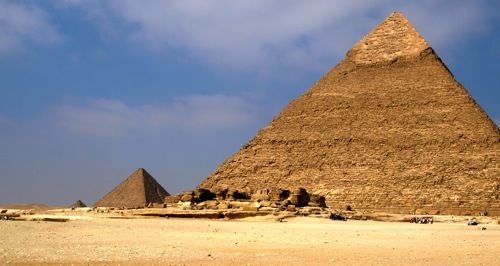
The Pyramids of Giza consist of the most amazing and
world-renowned features in all of Egypt. The sites you will see in Giza
are so revered that that they are downright iconic of Egyptian culture.
Giza is not actually a city but the western district of Cairo. Giza has
also become increasingly popular as a commercial area, especially along
Pyramids Road.
What to See?
What can you expect to see in Giza and on all the best tours of Cairo,
Egypt? First and foremost, you have the Egyptian
Pyramids. Any guided tours that are worth a penny will tour the Pyramids
of Giza, one of the Seven Wonders of the World. It might surprise you to
discover that the Egyptian Pyramids, while still in tact internally and
externally, are surrounded by urban development. While visitors may come
expecting to find the Pyramids in an isolated desert, what they will
actually see is this natural attraction standing adjacent to businesses
like McDonalds and Pizza Hut.
What can you expect of luxury tours that visit the Ancient Pyramids?
Expect the insides of the Pyramids to be hot, humid and perhaps even a bit
scary, especially if you have claustrophobia. Once you’re in though, you
will be delighted by the miraculous achievement of these millennium-old
creations - all the more impressive considering they were built by human
hand.
Pyramids to look for by name include Khufu (at nearly five hundred feet
high), Khafre and Menkaure.
The Sphinx
Besides the Pyramids, another popular feature on Giza Pyramids tours is
the Sphinx and the Temple of the Sphinx. This human headed lion was
originally built in honor of the sun god Re-Horakhty. Is your curiosity
piqued by the Sphinx’s missing nose? No, the ancient Egyptians didn’t have
a sense of humor. What is believed to be the cause of the missing nose is
that bored soldiers once used the Sphinx as target practice. (The culprits
have been suggested to be anyone from World War I British troops, to
Napoleon’s army, to even Turks of the old era)
Please Note!
Can you climb the Pyramids? No, though at once time it
was allowed. Unfortunately climbing these amazing structures is no longer
allowed, though some claim that guards (in less frequented areas) can be
bribed to allow some climbing activity.
Last but not least, expect to be offered a camel ride on these Giza
Pyramids tours. We generally do NOT recommend a camel at the Giza
Pyramids. If you should choose to go for a ride expect to haggle and
expect to be cheated. Before and after the ride... Nevertheless, you have
to sample Giza in order to say you have truly seen the grandeur of Ancient
Egypt! In other words: Giza Pyramids tours are an absolute must when
visiting Cairo.
Discover the Magic of Giza Pyramids Tours
Cruise the Nile, explore the Pyramids and dive the Red Sea. All of this
awaits you and can be planned with our customized Egypt travel packages.
Contact us today and start planning your dream trip with us.
Tour the Egyptian Museum in Cairo
The Egyptian Museum in Cairo provides you with the
opportunity to see Egypt ancient history up close and personal. This
museum is a must on your Cairo travel itinerary.
Visiting the Museum is a Must
Cairo has a number of wonderful things to offer to visitors. It is located
on the beautiful Nile, and it is close to some of the most famous sites in
all of Egypt – the Great Pyramids of Egypt and the Sphinx. Everyone who
comes to the beautiful city will find a number of wonderful things that
will keep him or her busy.
The Egyptian government established the museum, located in Cairo, in 1835.
They began the museum as an effort to stop all of the plundering and
looting that was going on at all of the different archaeological sites in
the area. The museum would protect the priceless artifacts that trace
Egypt's past.
The museum has a number of wonderful items in their collection. When you
visit Cairo, you must stop by the museum and take a look at everything it
has to offer.
Funerary Works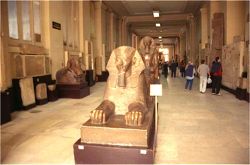
The
Egyptians have a very unique belief in the afterlife, and this collection
contains many traces of that. One can see sarcophagi, funeral art, and
many other items and artifacts.
Jewelry
Egyptian jewelry is beautiful and unique, and the museum has the most
incredible collections in the world. You can see jewelry of both silver
and gold, some even inset with precious stones. The workmanship is highly
detailed and beautiful.
Sculpture
Egyptian sculpture was used for religious depictions and was often located
in temples and tombs. The museum houses a number of different sculptures
from throughout the history of the culture of Egypt. The attention to
detail in the sculptures is incredible.
Some of the most impressive pieces in the collection are a sculpture of
the goddess Selket from the Canopic Shrine and the bust of King Merenptah.
You can find a wide variety of sculptures.
King Tut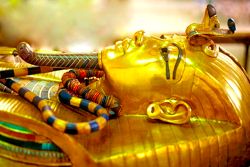
Probably the most famous artifacts in the entire museum belong to the King
Tut collection. A boy king, he ruled for only nine years, but his power
and legend are still felt today. He had in incredible collection of
treasure and much of that is located at the museum.
Some of the most impressive pieces in this collection are shields,
bracelets, jewelry and more. The collection is vast, and has a great
variety of items.
Anyone who comes to Cairo should make certain to visit the Egyptian
Museum. It makes a great place to visit along with the pyramids and the
other historical sites.
Museums Everywhere
Though it may seem like the entire country of Egypt is a museum, it is in
fact home to some of the finest museums in the world. Our experts can help
you plan a visit to many of them.
The Luxor, Egypt Travel Guide
Luxor, Egypt is located in Upper Egypt,
and is the site of the ancient city of Thebes. As a site with so much
history, it has a number of historic areas that are very popular tourist
destinations. Some of the most popular of the historic places to visit in
the Luxor area are the Temple of Luxor, the Temple of Karnak, as well as
the Valley of the Kings and the Valley of the Queens.
If you are planning a trip to Egypt you have probably scheduled
some time in Luxor, but with our specialized assistance you can be sure to
see the most important and finest sites within the entire area. Come and
enjoy the adventure of a lifetime!
Founded in 1400 BCE, the Luxor Temple was
a site of ancient rites to the gods Amun, Chons and Mut. Egypt tours
without a stop here are incomplete!
Many Fascinating Aspects
Located in Luxor, Egypt this temple of Luxor has many fascinating aspects
and features that continue to attract multitudes of people. The temple of
Luxor, some 260 m (850 ft) long today, was built by Amenophis III on the
foundations of a previous religious structure, dating from the time of
Queen Hatshepsut.
The Luxor Temple Colonnades
One of the glories of the ancient Egyptian temple of Luxor is a majestic
colonnade dating to the reign of Amenophis III, with 14 columns with
papyrus-shaped capitals standing 18 m (60 ft) tall, and almost 10 m (33
ft) in circumference. The colonnade is enclosed on both sides by a masonry
curtain wall, with reliefs depicting various phases of the Festival of
Opet, completed and decorated during the reigns of Tutankhamun and
Horemheb.
A magnificent courtyard follows; it is lined with a double row of columns,
and bordered to the south by the hypostyle hall, which itself contains 32
gigantic columns. From here, the visitor passes on to the inner section of
the attraction where there is a series of four antechambers and ancillary
rooms, as well as the Sanctuary of the Sacred Barque, situated in the
innermost room. The chapel was rebuilt by Alexander the Great.
The ceremonies that took place in the Luxor temple were of great
importance, and their religious symbolism complex. During the Festival of
Opet, the feast of the royal jubilee, the divine rebirth of the pharaoh,
son of Amun, was celebrated, reaffirming in this way his power.
The ancient Egyptian temple of Luxor also served as a shrine for the
worship of the divine and immortal portion of the pharaoh, the royal "ka",
symbol of the legitimacy of the pharaoh's power, which was universal and
not restricted to any individual pharaoh.
In terms of purity of structural design and the elegance of its columns,
the temple is one of the most remarkable architectural achievements of the
New Kingdom.
Courtyard of Ramsees II
The courtyard of Ramses II, is surrounded by a peristyle of 74 papyrus
columns arranged in a double row and adorned with 16 statues of the
pharaoh, and incorporates a three-part chapel on the northern side, also
dedicated to the Theban triad and dating to Hatshepsut's reign.
The Obelisks
Also dating to the reign of Ramses II are two large obelisks that once
stood before the first pylon (a word derived from the Greek meaning
'gateway') and which were given to France by the ruler of Egypt, Mohammad
Ali, in 1819.
The western obelisk in the Luxor temple, more than 21 m (70 ft) tall and
weighing 210 tons, was removed by the French in 1836 and erected in Paris
in the Place de la Concorde. All claims to ownership over the second
obelisk, which remained in its position in Egypt, were renounced by France
in 1980.
The Abu El Haggag Mosque
On the eastern side of the Luxor Temple Ramses II courtyard a Byzantine
church was built in the sixth century AD, and on top of that, during the
reign of the Ayyubid sultans (thirteenth century AD), the mosque of Abu
El-Haggag was built. The Abu El Haggag Mosque is still in use today as a
place of prayer.
Looking for a Special Luxor Adventure?
With our specialized expertise we can help you plan the most memorable
vacation of a lifetime, including scuba diving, desert treks, ancient
temples and more!
The Aswan Travel Guide
Aswan, Egypt is a city located in the southern part of
Egypt and located on the banks of the Nile River. This beautiful city is
just over 80 miles south of Luxor. The city has a number of different
things for visitors to see and do, including ancient temples, mosques,
islands, bazaars, and more.
You can see the wonders of Egypt and Aswan your way with a
personalized package that we customize to your preferences. Any budget,
any type of travel, we can do it for you.
Tour the Philae Temple of Isis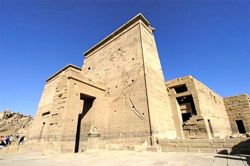
The Philae Temple was once the center of
worship for the goddess Isis. Now located on the island of Agilika, the
Temple provides an amazing experience for visitors.
Temple of Philae/Temple of Isis
Have you heard about the Philae Temple or the Temple of Isis in Egypt? The
word Philae (depending on whether you consider Greek or Egyptian meanings)
usually carries the connotation of a remote place, or the end angle of an
island. The ancient Egyptians called the island P-aaleq, which carried a
dual meaning of the words “end” and “creation.”
When you read about the Philae Temple you are studying about the main
temple complex that was relocated from the island of Philae to the island
of Agilika, following the creation of the High Dam. The actual island of
Philae doesn’t exist anymore, as it is now somewhere beneath the Lake
Nasser.
The Significance of the Temple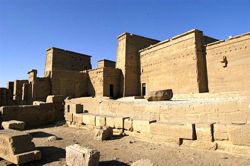
What is the significance of the Philae Temple in Egypt? It is believed to
be the former center point of worship to the goddess Isis that saw use
during the Ptolemaic period of Ancient Egypt. Historians speculate that
given all the different structures once found on Philae Island, the total
time of construction may have taken 800 years.
The island of Philae was home to both priests as well as workingmen, which
included stonemasons and carpenters that were helping with these elaborate
construction projects their entire lives.
The Relocation Project
What happened to the Philae Temple and why does the island of Philae not
exist anymore? In 1902 the Aswan Low Dam was completed on the Nile River,
courtesy of British developers.
Unfortunately, this massive project threatened many ancient landmarks,
including the temple complex of Philae. The real island of Philae was
constantly being flooded, even when the dam was heightened on two
instances, first from 1907 to 1912 and then 1929 to 1934. Eventually it
was decided that the temples of Philae should be relocated in order to
preserve their history.
Therefore, the relocation project began after 1960 when UNESCO formulated
a plan to move each structure, piece by piece. The pieces were reassembled
at Agilkai a little over 500 meters away and the site continues to stand
to this day. The physical part of the relocation lasted from 1977 to 1980.
Obviously, the natural beauty of the temples enhanced by live vegetation
and vivid color has been “washed away” through time. However, the temple
structures remain intact and are surprisingly accurate compared to the
original layout. This is because every block of the temple was labeled and
its positions carefully noted so that it could be replicated, not merely
duplicated.
The relocation project is so detailed that even the elevated land of the
original temple has been recreated through landscaping. You most likely
couldn’t tell the difference - provided you were born in the 1800s and had
the luxury of comparison.
The Philae Temple is not only a landmark of architecture but also an
incredible story of construction and reconstruction.
The Alexandria, Egypt Travel Guide
The city of Alexandria, Egypt is one of
the largest and most populated in Egypt and has a population of more than
four million. Situated along the Mediterranean Sea, the city is also the
largest seaport in Alexandria.
Alexandria is a popular destination for cruise line passengers arriving at
the Alexandria Port and having 12 hours to 2 days time for sightseeing in
Egypt.
Find Your Tours From
Alexandria Port Here...
The Citadel of Qaitbey, Alexandria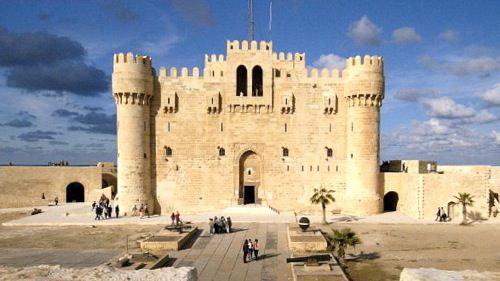
The Citadel of Qaitbey is a fortress
located on the edge of the Mediterranean, and was built on the ruins of
the famous Lighthouse of Alexandria.
History of the Fort
Standing on the foundations of one of the famous “Seven Wonders of the
World” is the Qaitbey Citadel, Alexandria, Egypt.
This fortress is seated upon the exact location of the Lighthouse of
Alexandria which was completely eliminated by several earthquakes over the
centuries, beginning in the 800s and continuing to the eleventh century.
By the fourteenth century the entire site had been destroyed and the
Mameluke Sultan Al-Ashraf Qaitbay decided to use the location as a
defensive fort.
A castle was constructed on the location, with a mosque contained inside
of it, and it continued to work its defensive wonders well into the 1800s.
The Qaitbey Citadel did experience years of decline and neglect, but was
taken in hand by the Egyptian Supreme Counsel of Antiquities within the
last century and is now fully restored and open for visitation.
A Defense Against the Turks
Though the Qaitbey Citadel was initially constructed as a defense against
the Ottoman Turks it eventually fell into their hands, and they actually
maintained the building quite well.
Later the French were able to defeat the Turks and, in turn, took
possession of the building, and in the late 1700s were astounded to find
that some of the weapons used during the Crusades remained within the
Qaitbey Citadel’s walls.
|
|













